The Patterns and Associations between Attitudes towards Active Travel and Physical Activity among Residents in Three Selected Provinces of Thailand
DOI:
https://doi.org/10.59096/osir.v17i4.270477Keywords:
physical activity, active transport, attitude, community, ThailandAbstract
Active travel offers opportunities for regular physical activity, influenced by socio-demographic, socio-economic, and socio-psychological determinants. This study investigated the associations between positive attitudes towards active travel environments and literacy with sufficient physical activity in Thailand. A cross-sectional study was conducted with 343 residents recruited from three communities in 2019. A self-administered questionnaire collected data on demographics, physical activity levels (using the Global Physical Activity Questionnaire), and attitudes towards 11 supportive conditions for active travel. Factor analysis identified three factors: (1) attitudes towards public transport environments, capturing perceptions of convenience, attractiveness, and affordability; (2) attitudes towards walking and cycling environments, reflecting supportive conditions like safety and conduciveness; and (3) active travel literacy, relating to awareness and understanding of active travel concepts. Multivariable logistic regression analysis revealed that participants with positive attitudes towards public transport environments (adjusted odds ratio (AOR) 2.06, 95% confidence interval (CI) 1.01–4.17) and active travel literacy (AOR 2.93, 95% CI 1.10–7.79) had a significantly higher likelihood of achieving sufficient physical activity. Policymakers should prioritize enhancing the convenience, attractiveness, and affordability of public transport and promote educational campaigns to boost active travel literacy and encourage active travel behaviors.
References
Lee IM, Shiroma EJ, Lobelo F, Puska P, Blair SN, Katzmarzyk PT, et al. Effect of physical inactivity on major non-communicable diseases worldwide: an analysis of burden of disease and life expectancy. Lancet. 2012;380(9838):219–29. doi:10.1016/S0140-6736(12)61031-9.
Strain T, Flaxman S, Guthold R, Semenova E, Cowan M, Riley LM, et al. National, regional, and global trends in insufficient physical activity among adults from 2000 to 2022: a pooled analysis of 507 population-based surveys with 5.7 million participants. Lancet Glob Health. 2024 Aug;12(8):e1232-e1243. doi:10.1016/S2214-109X(24)00150-5.
Ekpalakorn V, editor. The 4th Thai national health examination survey 2008-2009. Nonthaburi: Health System Research Institute; 2009.
Ekpalakorn V, editor. The 5th Thai national health examination survey 2014-2015. Nonthaburi: Health System Research Institute; 2015.
Ekpalakorn V, editor. The 6th Thai national health examination survey 2019–2020. Nonthaburi: Health System Research Institute; 2020.
Katewongsa P, Pongpradit K, editors. Regenerating physical activity in Thailand after COVID-19 pandemic. Nakorn Pathom: Thailand Physical Activity Knowledge Development Center; Institute for Population and Social Research, Mahidol University; ThaiHealth Promotion Foundation; 2020. 108 p. Thai.
Topothai T, Tangcharoensathien V, Suphanchaimat R, Petrunoff N, Chandrasiri O, Muller-Riemenschneider F. Patterns of physical activity and sedentary behavior during the COVID-19 pandemic in the Thai 2021 national health survey. J Phys Act Health. 2023 Mar 14;20(5):364–73. doi:10.1123/jpah.2022-0528.
Division of Physical Activity and Health, Department of Health, Ministry of Public Health. Thailand Physical Activity Strategy 2018-2030 Bangkok: NC Concept; 2018.
Khamput T, Patsorn K, Thongbo T, Seunglee S, Keryai T, Sangsamritpol W, et al. Administration of physical activity promotion by twelve local administrative organizations in Thailand. Health Systems Research. 2019;13(1):63–89.
Mueller N, Rojas-Rueda D, Cole-Hunter T, de Nazelle A, Dons E, Gerike R, et al. Health impact assessment of active transportation: A systematic review. Prev Med. 2015 Jul:76:103–14. doi:10.1016/j.ypmed.2015.04.010.
Sener IN, Lee RJ, Elgart Z. Potential health implications and health cost reductions of transit-induced physical activity. J Transp Health. 2016;3(2):133–40. doi:10.1016/j.jth.2016.02.002.
Shephard RJ. Is active commuting the answer to population health? Sports Med. 2008;38(9): 751–8. doi:10.2165/00007256-200838090-00004.
Gerike R, de Nazelle A, Nieuwenhuijsen M, Panis LI, Anaya E, Avila-Palencia I, et al. Physical activity through sustainable transport approaches (PASTA): a study protocol for a multicentre project. BMJOpen. 2016;6(1):e009924. doi:10.1136/bmjopen-2015-009924.
Topothai T, Topothai C, Pongutta S, Suriyawongpaisan W, Chandrasiri O, Thammarangsi T. The daily energy expenditure of 4 domains of physical activity of Thai adults. Health Systems Research. 2015;9(2):168–80.
Topothai T, Liangruenrom N, Topothai C, Suriyawongpaisan W, Limwattananon S, Limwattananon C, et al. How Much of Energy Expenditure from Physical Activity and Sedentary Behavior of Thai Adults: The 2015 National Health and Welfare Survey. Health Systems Research. 2017;11(3):327–44.
Koszowski C, Gerike R, Hubrich S, Gotschi T, Pohle M, Wittwer R. Active mobility: bringing together transport planning, urban planning, and public health: challenges, solutions and collaborations. In: Muller B, Meyer G, editors. Towards user-centric transport in Europe: challenges, solutions and collaborations. Cham: Springer; 2019. p. 149–71. doi:10.1007/978-3-319-99756-8_11
Gotschi T, de Nazelle A, Brand C, Gerike R, Consortium P. Towards a comprehensive conceptual framework of active travel bbehavior: a review and synthesis of published frameworks. Curr Environ Health Rep. 2017;4(3):286–95. doi:10.1007/s40572-017-0149-9.
Cradock AL, Barrett JL, Chriqui JF, Evenson KR, Goins KV, Gustat J, et al. Driven to support: individual- and county-level factors associated with public support for active transportation policies. Am J Health Promot. 2017;32(3):657–66. doi:10.1177/0890117117738758.
Thailand Walking and Cycling Institute Foundation. The 7th Thailand Bike and Walk Forum 2019: Think Globally, Bike-Walk Locally. Bangkok: Thailand Walking and Cycling Institute Foundation; 2019. Thai
Topothai T, Topothai C, Suphanchaimat R, Chandrasiri O, Sukaew T, Putthasri W, et al. Physical activity, carbon dioxide emission and cost of transport: a case study of three communities in Thailand. Journal of Health Systems Research. 2020;14(4):458–77.
Kaewkungwal J, Singhasivanon P. Sample size calculation in clinical research. In: P itisuthitham P, Pichiensunthorn C, editors. Textbook of clinical research. Bangkok: Tropical Medicine Faculty, Mahidol University; 2011. p. 107–43. Thai.
Katewongsa P. National Physical Activity Survey 2011–2016. Nakorn Pathom: Institute for Population and Social Research, Mahidol University; 2016.
Brownson RC, Brennan Ramirez LK, Hoehner CM, Cook RA. Checklist audit tool [Internet]. Missouri: Saint Louis University, School of Public Health; 2003 [cited 2024 Dec 16]. <https://activelivingresearch.org/sites/activelivingresearch.org/files/audit_tool_checklist.pdf>
World Health Organization. Global recommendations on physical activity for health. Geneva: World Health Organization; 2010 Jan 1. 58 p.
World Health Organization. The Asia-Pacific perspective: redefining obesity and its treatment. Geneva: World Health Organization; 2000. 55 p.
Thalib L, Kitching R, Bhatti M. Principal component analysis for grouped data—a case study. Environmetrics. 1999;10(5):565. doi:10.1002/(SICI)1099-095X(199909/10)10:5<565::AID-ENV360>3.0.CO;2-R.
Liangruenrom N, Topothai T, Topothai C, Suriyawongpaisan W, Limwattananon S, Limwattananon C, et al. Do Thai people meet recommended physical activity level?: the 2015 national health and welfare survey. Journal of Health Systems Research. 2017;11(2):205–20.
Topothai T, Topothai C, Suphanchaimat R, Chandrasiri O, Sukaew T, Putthasri W, et al. The promotion of walking and biking for transportation, and public transport using: a case study in four communities in Thailand. Journal of Health Systems Research. 2021;15(3):294–309
Piriyawat S, Intanu C. Explaining traveler's intention towards bicycle usages in daily life by using model of goal directed behavior theory: Bangkhla, Chachoengsao case study. In: Mode shift: bike and walk to public transport connection. Proceeding of the 6th Thailand Bike and Walk Forum; 2018 Mar 9–10; Bangkok, Thailand. Bangkok: Thailand Walking and Cycling Institute Foundation; 2018. p. 141–56. Thai.
Piriyawat S. Investigating Problems and Obstructions on Bicycle Usages in Daily Life and Policy Processes for Overcoming the Problems: Bangkhla, Chachoengsao Case Study. In: Think globally, bike-walk locally. Proceeding of the 7th Thailand Bike and Walk Forum; 2019 Sep 21; Bangkok, Thailand. Bangkok: Thailand Walking and Cycling Institute Foundation; 2019. p. 103-17. Thai.
Chiangkam Subdistrict Municipality. Community action plan 2020. Chiangkam (TH): Chiangkam Subdistrict Municipality; 2019.
Rojas-Rueda D. Health impact assessment of active transportation. In: M. Nieuwenhuijsen, Khreis H, editors. Integrating Human Health into Urban and Transport Planning. Cham: Springer International Publishing; 2019. p. 625–40.
Gotschi T, Tainio M, Maizlish N, Schwanen T, Goodman A, Woodcock J. Contrasts in active transport behaviour across four countries: how do they translate into public health benefits? Preventive medicine. 2015;74:42–8. doi:10.1016/j.ypmed.2015.02.009.
Mizdrak A, Blakely T, Cleghorn CL, Cobiac LJ. Potential of active transport to improve health, reduce healthcare costs, and reduce greenhouse gas emissions: A modelling study. PLoS One. 2019;14(7):e0219316. doi:10.1371/journal.pone.0219316.
Zapata-Diomedi B, Knibbs LD, Ware RS, Heesch KC, Tainio M, Woodcock J, et al. A shift from motorised travel to active transport: What are the potential health gains for an Australian city? PLoS One. 2017;12(10):e0184799. doi:10.1371/journal.pone.0184799.
Richards R, Murdoch L, Reeder AI, Amun QT. Political activity for physical activity: health advocacy for active transport. Int J Behav Nutr Phys Act. 2011;8:52. doi:10.1186/1479-5868-8-52.
Richards R, Murdoch L, Reeder AI, Rosenby M. Advocacy for active transport: advocate and city council perspectives. Int J Behav Nutr Phys Act. 2010;7:5. doi:10.1186/1479-5868-7-5.
Cerin E, Sallis JF, Salvo D, Hinckson E, Conway TL, Owen N, et al. Determining thresholds for spatial urban design and transport features that support walking to create healthy and sustainable cities: findings from the IPEN Adult study. Lancet Glob Health. 2022;10(6):e895–e906. doi:10.1016/S2214-109X(22)00068-7.
Downloads
Published
How to Cite
Issue
Section
License
Copyright (c) 2024 Outbreak, Surveillance, Investigation & Response (OSIR) Journal

This work is licensed under a Creative Commons Attribution-NonCommercial-NoDerivatives 4.0 International License.









